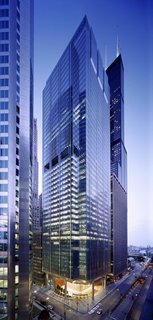
Effective today, November 1st, the architectural firm previously known as Lohan Caprile Goettsch Architects has officially been rechristened Goettsch Partners, taking the name of James Goettsch, the long-time Chicago architect who spent two decades with C.F. Murphy-Murphy/Jahn in the 70's and 80's before joining his present firm, which traces its lineage back to the original offices of Mies van der Rohe. The name change follows the 2004 departure from the firm of Dirk Lohan, Mies's grandson, to form Lohan Anderson LLC, and the surprise resignation last month of co-President Joseph Caprile. Goettsch is one of six principals who will run the firm that includes James Zheng, who has moved up from Associate Principal. Let's hope the business cards and stationary arrived on time - the company's web site continues to feature the Lohan Caprile Goettsch name.
(An aside to the folks responsible for the design of the Lohan Anderson web site: when you offer an alternative option to Open Fullscreen labeled Open in Pop-Up Window that also opens a window taking over your entire desktop, it's really annoying, especially if you have a large screen.)
The firm latest completed project is 111 S. Wacker, for the John Buck Company, which it claims as "the world’s first high-rise certified LEED-CS Gold." An interesting article in The Chief Engineer details some of structures most prominent features, including a 44-foot-high lobby ceiling formed by the underside of a parking ramp, and a floating foundation poured over the cassions of the old U.S. Gypsum building, a handsome Perkins & Will structure, turned 45 degrees on its site, that has the unfortunate distinction of being the first modern skyscraper to be demolished in Chicago, replaced in 1993 by a surface parking lot. In a post 9-11 move, 111 S. Wacker has stairs that transfer away from the core at the 10th floor, not to the lobby, but to a perimeter exit. There's a separate entrance for fire and emergency workers and equipment. The final component enabling the LEED certification is a green roof planted with wild-growing grasses.
No comments:
Post a Comment